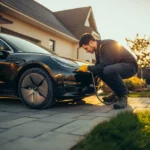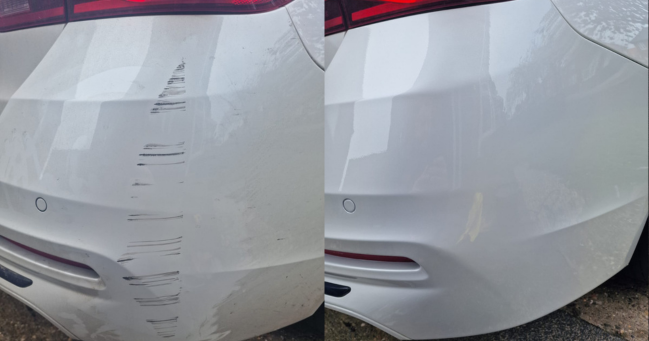
- February 25, 2025
Car dents are an unfortunate reality for many vehicle owners. Whether caused by a stray shopping trolley, a careless driver in a car park, or even a sudden hailstorm, dents can be frustrating and unsightly. However, not all dents are the same, and each requires a different repair method. In this guide, we’ll explore the most common types of car dents, their causes, and the best ways to repair them.
Why Fix Car Dents?
While some dents may seem like just a minor inconvenience, leaving them untreated can lead to bigger problems. Dents that break through the paint expose the metal underneath, which can lead to rust and further degradation of the vehicle’s bodywork. Additionally, dents can lower the resale value of a car and affect its overall aesthetic appeal.
Different Types of Car Dents and How to Fix Them
1. Round Dents (Door Dings & Shopping Trolley Dents)
What Causes Them?
Round dents are one of the most common types of minor vehicle damage. They typically occur when a car door is opened onto your vehicle or when a shopping trolley bumps into it. These dents usually don’t crack the paint but can still be quite noticeable.
How to Repair Them
If the dent is shallow and the paint remains intact, Paintless Dent Removal (PDR) is the ideal solution. This technique involves using specialised tools to massage the dent out from behind the panel gently.
If the dent has slightly cracked the paint, a SMART repair (Small to Medium Area Repair Technology) may be required, blending new paint seamlessly with the existing finish.
2. Crease Dents
What Causes Them?
Crease dents are long, narrow indentations that occur when an object drags across the surface of a car, such as a bicycle handlebar or a tree branch. These dents often distort the metal, making them harder to fix than round dents.
How to Repair Them
PDR can sometimes work for minor creases, but due to the stretching of the metal, it may not be entirely effective.
Deeper creases often require glue pulling techniques or even panel beating and repainting to restore the car’s surface.
3. Sharp Dents (Impact Dents)
What Causes Them?
Sharp dents are deep, sharply indented marks that result from significant impact, such as a vehicle hitting a bollard or another car. These dents often have defined edges and may have accompanying paint damage.
How to Repair Them
If the metal isn’t stretched too much, PDR or glue-pulling methods can help.
If the damage is deep or if the paint is cracked, a SMART repair or body shop repair (filling, sanding, and repainting) may be required.
4. Hailstone Dents
What Causes Them?
Hail dents occur when hailstones or other small debris hit the car’s surface. These dents are typically small and round and are often found on the bonnet, roof, and boot of the vehicle.
How to Repair Them
PDR is usually the best option for hail damage, as it preserves the original paint.
If the damage is extensive, a combination of PDR and light filler/spray blending may be necessary.
5. Bumper Dents
What Causes Them?
Bumper dents are typically caused by low-speed collisions, such as minor parking accidents. Since bumpers are made from plastic, they absorb impacts differently from metal panels.
How to Repair Them
Some bumper dents can be heated and reshaped back into place without needing a full repair.
If the paint is cracked or scratched, a SMART repair may be required.
For severe damage, bumper replacement may be the best option.
6. Multi-Point Dents (Collision Damage)
What Causes Them?
Large, irregular dents typically occur during accidents or significant impacts. These dents can span multiple panels and may result in paint cracking and metal stretching.
How to Repair Them
Panel beating, filling, and full respraying are usually necessary.
In severe cases, the entire panel may need to be replaced.
7. Folded Metal Dents
What Causes Them?
These dents occur when the metal folds over itself, often seen along door edges or wheel arches. These are among the most difficult dents to repair.
How to Repair Them
May require panel beating and reshaping
If the damage is too severe, the panel may need replacing.
8. Car Roof Dents
What Causes Them?
Often caused by falling objects, hail, or people leaning on the roof, these dents can vary in size and severity.
How to Repair Them
PDR works well for minor dents, while larger dents may require filler and repainting.
If the structure of the roof is compromised, a professional assessment is required.
Which Repair Method is Right for Your Car Dent?
| Type of Dent | Best Repair Method |
|---|---|
| Round Dents (Door Dings) | PDR / SMART Repair |
| Crease Dents | PDR / Glue Pulling / SMART Repair |
| Sharp Dents | PDR (if minor) / SMART Repair / Body Shop |
| Hailstone Dents | PDR / Panel Respray (if severe) |
| Bumper Dents | Heat Reshaping / SMART Repair |
| Multi-Point Dents | Panel Beating / Full Respray |
| Folded Metal Dents | Panel Beating / Replacement |
| Roof Dents | PDR / Filler & Paint Repair |
How to Prevent Car Dents
While accidents happen, there are steps you can take to reduce the likelihood of getting dents:
- Park further away from other vehicles in car parks to avoid door dings.
- Use car covers if parking under trees or in areas prone to hail.
- Apply paint protection film (PPF) to vulnerable areas.
- Drive cautiously on gravel roads to reduce stone chip damage.
Final Thoughts: Choosing the Right Dent Repair Method
Car dents are frustrating, but they don’t have to be permanent. Whether it’s a minor door ding or significant collision damage, there are effective repair solutions available. Mobile SMART repair services offer a cost-effective and professional way to fix minor dents without the need for a trip to the body shop.
By addressing dents quickly, you can maintain the appearance and value of your car while preventing further damage such as rust. If you’re unsure of the best repair method, it’s always advisable to consult with a professional dent repair specialist to ensure a flawless finish.


